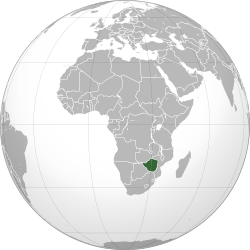| |||||||||
|---|---|---|---|---|---|---|---|---|---|
| 1965–1979 | |||||||||
| Motto: Sit Nomine Digna (Latin) May she be worthy of the name | |||||||||
| Anthem: "God Save the Queen" (1965–1970) "Rise, O Voices of Rhodesia" (1974–1979) | |||||||||
 | |||||||||
| Status | Unrecognised state | ||||||||
| Capital and largest city | Salisbury | ||||||||
| Official languages | English (de facto) | ||||||||
| Other languages | |||||||||
| Ethnic groups (1969) | |||||||||
| Demonym(s) | Rhodesian | ||||||||
| Government |
| ||||||||
| Queen[a] | |||||||||
• 1965–1970 | Elizabeth II | ||||||||
| President | |||||||||
• 1970–1975 | Clifford Dupont | ||||||||
• 1975–1976 | Henry Everard (acting) | ||||||||
• 1976–1978 | John Wrathall | ||||||||
• 1978 | Henry Everard (acting) | ||||||||
• 1978–1979 | Jack Pithey (acting) | ||||||||
• 1979 | Henry Everard (acting) | ||||||||
| Prime Minister | |||||||||
• 1965–1979 | Ian Smith | ||||||||
| Legislature | Parliament | ||||||||
| Senate | |||||||||
| House of Assembly | |||||||||
| Historical era | Cold War and decolonisation of Africa | ||||||||
• Declared | 11 November 1965 | ||||||||
• Republic | 2 March 1970 | ||||||||
| 3 March 1978 | |||||||||
| 1 June 1979 | |||||||||
| Area | |||||||||
• Total | 390,580 km2 (150,800 sq mi) | ||||||||
| Population | |||||||||
• 1978 census | 6,930,000 | ||||||||
| Currency |
| ||||||||
| Time zone | UTC+2 (CAT) | ||||||||
| ISO 3166 code | RH | ||||||||
| |||||||||
| Today part of | Zimbabwe | ||||||||
| |||||||||
Rhodesia (/roʊˈdiːʒə/ roh-DEE-zhə, /roʊˈdiːʃə/ roh-DEE-shə;[1] Shona: Rodizha), officially from 1970 the Republic of Rhodesia,[2][3] was an unrecognised state in Southern Africa from 1965 to 1979. During this fourteen-year period, Rhodesia served as the de facto successor state to the British colony of Southern Rhodesia, and in 1980 it became modern day Zimbabwe.
Southern Rhodesia had been self-governing since achieving responsible government in 1923. A landlocked nation, Rhodesia was bordered by Botswana (Bechuanaland: British protectorate until 1966) to the southwest, Mozambique (Portuguese province until 1975) to the east, South Africa to the south, and Zambia to the northwest. From 1965 to 1979, Rhodesia was one of two independent states on the African continent governed by a white minority of European descent and culture, the other being South Africa.
In the late 19th century, the territory north of the Transvaal was chartered to the British South Africa Company, led by Cecil Rhodes. Rhodes and his Pioneer Column marched north in 1890, acquiring a huge block of territory that the company ruled until the early 1920s. In 1923, the company's charter was revoked, and Southern Rhodesia attained self-government and established a legislature. Between 1953 and 1963, Southern Rhodesia was joined with Northern Rhodesia and Nyasaland in the Federation of Rhodesia and Nyasaland.
The rapid decolonisation of Africa in the late 1950s and early 1960s alarmed a significant proportion of Southern Rhodesia's white population. In an effort to delay the transition to black majority rule, the predominantly white Southern Rhodesian government issued its own Unilateral Declaration of Independence (UDI) from the United Kingdom on 11 November 1965. The new nation, identified simply as Rhodesia, initially sought recognition as an autonomous realm within the Commonwealth of Nations, but reconstituted itself as a republic in 1970.
Following the declaration of independence in 1965,[4] the United Nations Security Council passed a resolution that called upon all states not to grant recognition to Rhodesia. Two African nationalist parties, the Zimbabwe African People's Union (ZAPU) and Zimbabwe African National Union (ZANU), launched an armed insurgency against the government upon UDI, sparking the Rhodesian Bush War. Growing war weariness, diplomatic pressure, and an extensive trade embargo imposed by the United Nations prompted Rhodesian prime minister Ian Smith to concede to majority rule in 1978. However, elections and a multiracial provisional government, with Smith succeeded by moderate Abel Muzorewa, failed to appease international critics or halt the war. By December 1979 Muzorewa had secured an agreement with ZAPU and ZANU, allowing Rhodesia to briefly revert to colonial status pending new elections under British supervision. ZANU secured an electoral victory in 1980, and the country achieved internationally recognised independence in April 1980 as Zimbabwe.
Rhodesia's largest cities were Salisbury (its capital city, now known as Harare) and Bulawayo. Prior to 1970, the unicameral Legislative Assembly was predominantly white, with a small number of seats reserved for black representatives. Following the declaration of a republic in 1970, this was replaced by a bicameral Parliament, with a House of Assembly and a Senate. The bicameral system was retained in Zimbabwe after 1980. Aside from its racial franchise, Rhodesia observed a Westminster system inherited from the United Kingdom, with a President acting as ceremonial head of state, while a Prime Minister headed the Cabinet as head of government.
- ^ Chambers, Allied (1998). The Chambers Dictionary. Allied Publishers. p. 1416. ISBN 978-81-86062-25-8.
- ^ Votes and Proceedings of the Senate, Volume 12, Parliament of Rhodesia, 1970, page 2
- ^ "46. Rhodesia/Zimbabwe (1964-present)". uca.edu.
- ^ History, Elizabeth Schmidt / Made by (30 October 2023). "A Lesson From the History of Rhodesia". TIME. Retrieved 3 September 2024.

